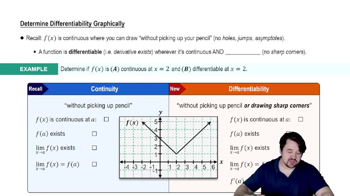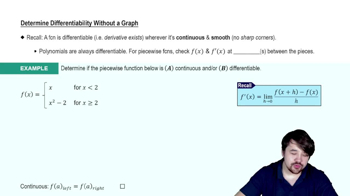Table of contents
- 0. Functions7h 52m
- Introduction to Functions16m
- Piecewise Functions10m
- Properties of Functions9m
- Common Functions1h 8m
- Transformations5m
- Combining Functions27m
- Exponent rules32m
- Exponential Functions28m
- Logarithmic Functions24m
- Properties of Logarithms34m
- Exponential & Logarithmic Equations35m
- Introduction to Trigonometric Functions38m
- Graphs of Trigonometric Functions44m
- Trigonometric Identities47m
- Inverse Trigonometric Functions48m
- 1. Limits and Continuity2h 2m
- 2. Intro to Derivatives1h 33m
- 3. Techniques of Differentiation3h 18m
- 4. Applications of Derivatives2h 38m
- 5. Graphical Applications of Derivatives6h 2m
- 6. Derivatives of Inverse, Exponential, & Logarithmic Functions2h 37m
- 7. Antiderivatives & Indefinite Integrals1h 26m
2. Intro to Derivatives
Differentiability
Problem 59
Textbook Question
Determining the unknown constant Let f(x) = {2x² if x≤1 ax-2 if x>1. Determine a value of a (if possible) for which f' is continuous at x=1.
 Verified step by step guidance
Verified step by step guidance1
Step 1: Understand the problem. We need to find a value of 'a' such that the derivative of the piecewise function f(x) is continuous at x=1. The function is defined as f(x) = 2x^2 for x ≤ 1 and f(x) = ax - 2 for x > 1.
Step 2: Ensure f(x) is continuous at x=1. For f(x) to be continuous at x=1, the left-hand limit (as x approaches 1 from the left) must equal the right-hand limit (as x approaches 1 from the right) and also equal f(1). Calculate these limits and set them equal to each other.
Step 3: Differentiate each piece of the function. Find f'(x) for x ≤ 1 and for x > 1. For x ≤ 1, differentiate 2x^2 to get f'(x) = 4x. For x > 1, differentiate ax - 2 to get f'(x) = a.
Step 4: Ensure f'(x) is continuous at x=1. For f'(x) to be continuous at x=1, the left-hand derivative (as x approaches 1 from the left) must equal the right-hand derivative (as x approaches 1 from the right). Set 4(1) equal to a.
Step 5: Solve for 'a'. From the equation 4 = a, determine the value of 'a' that makes f'(x) continuous at x=1.
Recommended similar problem, with video answer:
 Verified Solution
Verified SolutionThis video solution was recommended by our tutors as helpful for the problem above
Video duration:
2mPlay a video:
Was this helpful?

 5:02m
5:02mWatch next
Master Determining Differentiability Graphically with a bite sized video explanation from Callie
Start learningRelated Videos
Related Practice



